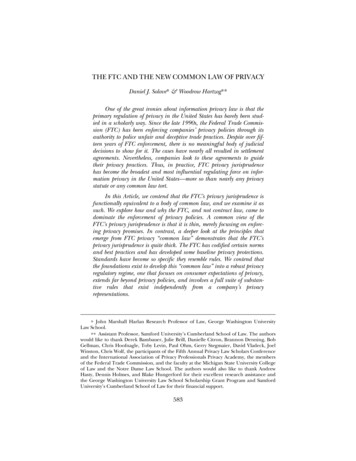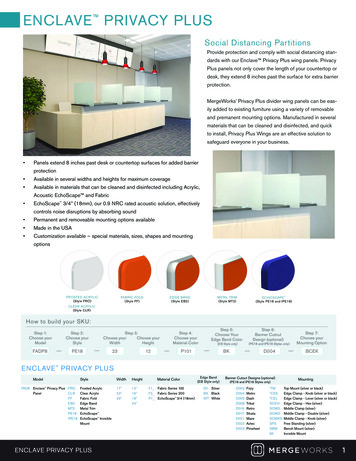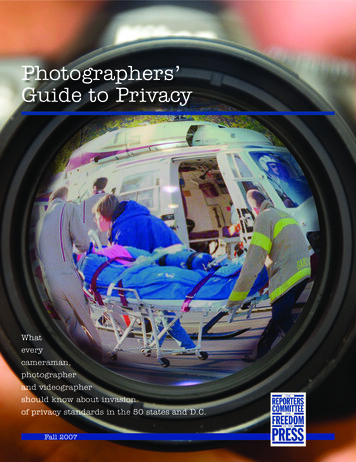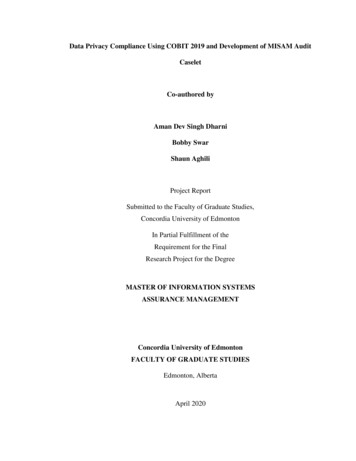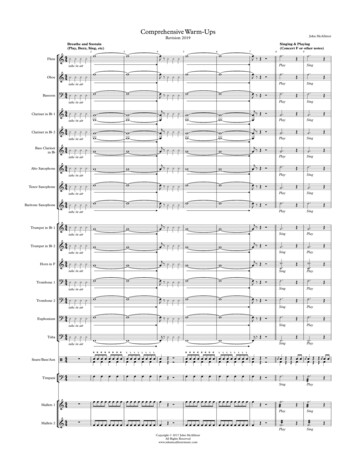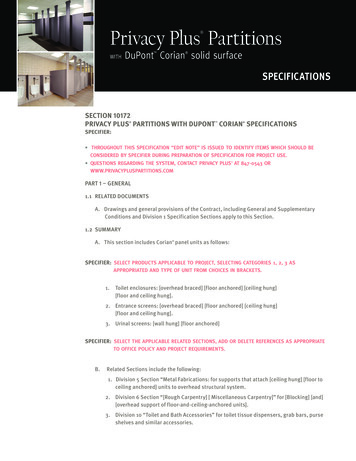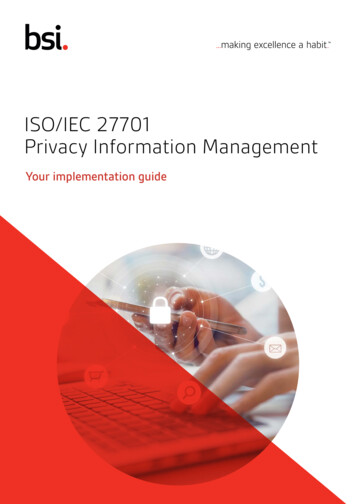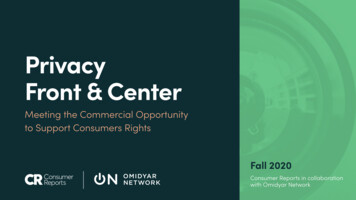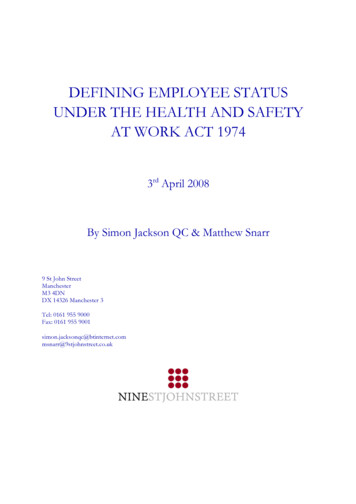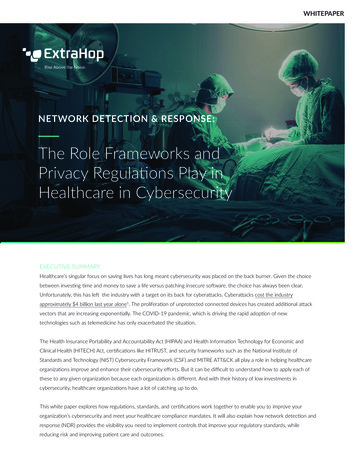
Transcription
WHITEPAPERRise Above the Noise.NETWORK DETECTION & RESPONSE:The Role Frameworks andPrivacy Regulations Play inHealthcare in CybersecurityEXECUTIVE SUMMARYHealthcare’s singular focus on saving lives has long meant cybersecurity was placed on the back burner. Given the choicebetween investing time and money to save a life versus patching insecure software, the choice has always been clear.Unfortunately, this has left the industry with a target on its back for cyberattacks. Cyberattacks cost the industryapproximately 4 billion last year alone1. The proliferation of unprotected connected devices has created additional attackvectors that are increasing exponentially. The COVID-19 pandemic, which is driving the rapid adoption of newtechnologies such as telemedicine has only exacerbated the situation.The Health Insurance Portability and Accountability Act (HIPAA) and Health Information Technology for Economic andClinical Health (HITECH) Act, certifications like HITRUST, and security frameworks such as the National Institute ofStandards and Technology (NIST) Cybersecurity Framework (CSF) and MITRE ATT&CK all play a role in helping healthcareorganizations improve and enhance their cybersecurity efforts. But it can be difficult to understand how to apply each ofthese to any given organization because each organization is different. And with their history of low investments incybersecurity, healthcare organizations have a lot of catching up to do.This white paper explores how regulations, standards, and certifications work together to enable you to improve yourorganization’s cybersecurity and meet your healthcare compliance mandates. It will also explain how network detection andresponse (NDR) provides the visibility you need to implement controls that improve your regulatory standards, whilereducing risk and improving patient care and outcomes.
TABLE OF CONTENTSIntroduction: Healthcare Faces a Broad Range of Cybersecurity Challenges 3The Role of Security Frameworks and Regulations in Improving Cybersecurity 4- HIPPA & HITECH 5- NIST 6- HITRUST 6- MITRE ATT&CK 7NDR: Enhance Compliance with Regulations and Frameworks 9- ExtraHop Reveal(x) 9Conclusion 11
HEALTHCARE FACES A BROAD RANGE OFCYBERSECURITY CHALLENGESHealthcare is the industry most targeted by cybercriminals,A proliferation of connected devices in the industry iswith a third of all data breaches in the United Statesexacerbating the situation. Healthcare organizations are inoccurring in hospitals2. And the problem continues to grow.the vanguard of adopting IoT devices, such as bloodBetween 2018 and 2019, the number of breached recordsglucose meters, blood pressure, monitors, and pulseincreased by 37 percent to 41.3 million3.oximeters, that allow providers to better understand andtrack patient health. A mid-sized hospital today hasAmong the major breaches that occurred in 2020, a20,000 medical devices, including about 10-15 devicesMidwest healthcare organization was forced to notify justper bed7. Many of these devices are inadequatelyunder 288,000 patients4 from 19 of its affiliated hospitalssecured, which means they can serve as entry points tothat their data was compromised after a successful phishingthe broader hospital network. For example, many IoTattack. In another incident, a hacker obtained thecameras in hospitals are inexpensive devices connectedcredentials of an employee from a Texas-basedby WiFi to a service that stores the recorded footage. Nothealthcare-centric organization to access the insurer’sonly is this insecure, if a Web camera’s video feed is opensystems and deploy malware. The attack breached the datato anyone on the network, that would be an instantof 274,837 patients from several providers and payers thatHIPAA violation.use their system for billing and collections services. ACalifornia-based clinical genomic diagnostic vendor,The COVID-19 pandemic has added further fuel to thesuffered an email hack that compromised the data offire by accelerating the adoption of remote care through232,772 patients.telemedicine. Telehealth claim lines increased 4,347percent nationally from 0.17 percent of medical claimRansomware is rapidly becoming one of the keylines in March 2019 to 7.52 percent in March of 2020.cybersecurity challenges for the healthcare industry. AThe increase was even greater in the Northeast, theCheck Point research report published in October of 2020region of the country where the pandemic hit hardest infound that ransomware attempts jumped 50 percent in theMarch8. Any change in an IT environment can increaseprevious three months compared to the first half of 2020,risk and when that change is rapid, risk has the potentialwith healthcare organizations the hardest hit5. Moreto rise rapidly.recently, a joint advisory6 was issued by the Cybersecurityand Infrastructure Security Agency (CISA), the Federal“This increased number of attacks makes it even moreBureau of Investigation (FBI), and the Department ofimportant for hospitals to heighten their ability toHealth and Human Services (HHS) that warned of cyberdetect and respond to potential threats before any dataactors targeting the healthcare sector using TrickBot andis compromised,” said Charles Alessi, MD, Chief ClinicalBazarLoader malware, resulting in ransomware attacks, dataOfficer at HIMSS.theft, and disruption of services.
THE ROLE OFSECURITYFRAMEWORKS ANDREGULATIONS INIMPROVINGCYBERSECURITYHealthcare regulations and cybersecurity frameworks are designed to give consumers and patientspeace of mind that their data will remain private and available only to providers. They also providehealthcare organizations with standards to follow to improve their overall security posture. Butapplying these standards and addressing regulations can get complex, because every organizationis different and no single, standard approach works for all.HIPAA and HITECH, NIST CSF, and HITRUST provide guidelines that enable organizations toprotect devices, networks, and sensitive patient health data and certify that appropriate actionswere taken to keep the data secure and private. The MITRE ATT&CK knowledge base helpssecurity analysts recognize the techniques used by attackers to better prepare for and respond toincidents.HIPAA and HITECH—are regulations intended to guarantee that patients can access, and controlHIPAA has amaximum penaltyof 1,785,651 forthe highest-levelviolationsaccess to, their personal data. The regulations also dictate how patient data and protected healthinformation (PHI) should be kept private and secure. The fines for noncompliance in 2020 rangefrom a minimum penalty of 119 for low level violations to a maximum penalty of 1,785,651 forthe highest-level violations9.NIST CSF—this cybersecurity framework provides industry-standard guidelines that CISOs canemploy to secure infrastructure across the organization. NIST offers a guide that helpsorganizations use its framework standards to implement HIPAA security requirements. The NISTCSF comprises voluntary recommendations and does not offer certification.HITRUST—Developed in collaboration with data protection professionals, the HITRUSTCybersecurity Framework (CSF), rationalizes relevant regulations and standards into a singleoverarching security and privacy framework. While this standard can be certified, most of theHIPAA compliance standards will carry over to meet the requirements.MITRE ATT&CK—is a globally-accessible knowledge base of adversary tactics and techniquesbased on real-world observations. This knowledge base helps healthcare organizations understandhow adversaries operate so they can plan how to better secure their networks and devices as wellas detect and stop attacks.THE ROLE FRAMEWORKS AND PRIVACY REGULATIONS PLAY IN HEALTHCARE IN CYBERSECURITY WHITEPAPER4
HIPPA and HITECHThe 2000 Health Insurance Portability and Accountability Act (HIPAA) Privacy Rule and the HITECH Actof 2009 require U.S. hospitals to safeguard patient data.HIPAA established individuals’ rights to obtain a copy of their health records from a covered healthcareprovider or health plan. The regulation also requires that healthcare organizations safeguard protectedhealth information (PHI) through administrative policies and technical safeguards that include auditlogging, backup, disaster recovery, and vulnerability scanning. As part of its mandate to protect patientdata, the HIPAA Security Rule requires that healthcare organizations provide cybersecurity safeguards,such as secure messaging, for electronically held PHI found in electronic health records (EHRs) andCompliantorganizationshave visibility toensure thatnothing out of theordinary is takingplace.medical devices. According to Jeff Costlow, CISO at ExtraHop, “HIPAA takes a very data centric-viewand focuses on protecting healthcare patient records. It’s all about providing specific actions you shouldtake to secure patient data.”HITECH was passed as part of the American Recovery and Reinvestment Act. The Act set aside fundsfor the creation of a nationwide network of electronic health records and initiated the Meaningful Useprogram. Because the Meaningful Use program incentivized healthcare providers to adopt technologyas they provided healthcare, HITECH incorporates HIPAA Privacy and Security Rules to addressconcerns about the electronic storage and transmission of medical records.JEFF COSTLOW, CISO, EXTRAHOPUpdates to HIPAA and HITECH often take one another’s regulations into account. For example,HITECH raised fines for noncompliance with HIPAA to a maximum of 1.5 million per violation andrequired healthcare organizations to comply with Breach Notification rules that require organizations tonotify individuals and in some cases the media of an unauthorized disclosure of PHI.To comply with HIPAA and HITECH regulations, healthcare organizations must be able to confirm thatthey properly address specified administrative, physical, technical, and organizational regulations andprocedures. Said Costlow, “Compliant organizations have visibility into what is connecting to theirnetwork, whether it’s a PC, laptop, or one of the myriad medical devices on most healthcare networkstoday. They must know what devices are communicating with each other, where their most sensitivedata is stored, who and what should access it, and how to best protect it. They can then monitor thosedevices and communications to ensure that nothing out of the ordinary is taking place.”HIPAA and HITECH provide no standard or implementation specification to enable Covered Entities orBusiness Associates to certify compliance. However, there are third parties who will conduct audits andattestations to assess companies and vendors to ensure they have the proper controls in place.THE ROLE FRAMEWORKS AND PRIVACY REGULATIONS PLAY IN HEALTHCARE IN CYBERSECURITY WHITEPAPER5
NISTOrganizations face potentially large fines for HIPAA and HITECH violations. Yet regulations canoften use vague language, making compliance difficult. The NIST CSF and NIST security controlsprovide an objective approach that healthcare organizations can follow to meet regulatoryrequirements in a systematic manner.NISTprovides acrosswalk thatmaps its securitystandards to theHIPAA standardand safeguardsNIST CSF is a voluntary framework that security teams can use to establish a comprehensive set ofsecurity standards across the organization. NIST provides high level recommendations for thingssecurity teams need to be able to do to improve their security and risk profiles.As a voluntary framework of recommendations, NIST has no penalties for non-compliance. NISTprovides a single set of guidelines that CISOs can turn to when dealing with fragmentedcybersecurity regulations. NIST also provides a crosswalk that maps its security standards to theHIPAA standard and safeguards, which makes it possible to achieve compliance in both NISTstandards and HIPAA regulations by following a single common framework.Some of the key NIST recommendations include: Identify—You can’t secure what you can’t see. As the first step in keeping unauthorizeddevices out of your environment or in preventing authorized devices from sending PHI wherethey shouldn’t, NIST suggests inventorying all devices in the healthcare environment andprofiling relevant data about them. Protect—NIST encourages healthcare organizations to limit access to physical and logicalassets to authorized users, processes, and devices and manage appropriate access permission.Additional suggested protective measures include using network segmentation to protectnetwork integrity and protecting the confidentiality and integrity of data in transit. Detect—In order for healthcare IT and security teams to detect anomalous activity more easily,NIST urges organizations to develop a baseline of network operations and expected dataflows. It also proposes reporting incidents in a consistent manner with well-established criteriaso organizations can address regulations with time sensitive reporting requirements. Recover—NIST suggests that healthcare organizations ensure effective response and recoveryby investigating notifications from detection systems and performing forensic investigations.HITRUSTHITRUST is a private organization that has developed a set of cybersecurity prescriptive controlscalled the Common Security Framework (CSF) that can help a healthcare organization ensure it hasproper HIPAA controls in place. “HITRUST comes in and evaluates your processes and proceduresand if they meet certain standards tells others that you are compliant with the regulations,”explained Costlow.THE ROLE FRAMEWORKS AND PRIVACY REGULATIONS PLAY IN HEALTHCARE IN CYBERSECURITY WHITEPAPER6
The HITRUST CSF is broken out into 19 different “domains” that are aligned with common ITprocess areas, including information protection, network protection, incident management,endpoint protection, and others. These 19 domains are further broken into 135 Security Controlsand 14 Privacy Controls that map back to multiple domains. Controls are then broken down intocontrol requirements.HITRUST helpshealthcareorganizationsensure they haveproper HIPAAcontrols in placeTo achieve HITRUST certification, organizations must achieve a passing score in each of the 19HITRUST domains. Each control requirement is scored and evaluated against five different maturitylevels based on the degree to which the control is implemented. The certification process looks atwhether the organization has: Policies in place to address the requirements of the controls Formally documented procedures for non-automated controls Implemented all the elements of the control requirements Continuous monitoring in place to measure and manage controlsThe score for each maturity level is based on the degree of implementation and the weighting ofthat maturity level.MITRE ATT&CK Framework & Medical Device Incident Response PlaybookCompliance is not the same as security. Concentration on HIPAA and penalties often steerhealthcare organizations to focus on data protection and not on overall operational security andresilience. Yet no matter how many HIPAA/HITECH/HITRUST compliance certifications anorganization has, a determined attacker can always find a way in. New attack methods areconstantly being developed, and since healthcare is a high-profile target, profit-driven attackers areinvesting in ways to attack healthcare organizations specifically. To prepare, hospitals need toprioritize overall security.The MITRE ATT&CK framework10 complements healthcare organizations’ cybersecurity efforts byproviding a knowledge base of real-world tactics that adversaries use to attack computer networks,including medical devices and telehealth infrastructures. MITRE ATT&CK was started in 2013 tocatalogue observed tactics, techniques, and procedures (TTPs) used by advanced persistent threats(APTs) and other types of attack. Organizations of all types and sizes use the framework to identifygaps in security coverage, with notable adherents including the U.S. Department of Health andHuman Services (HHS) and the National Health Information Sharing and Analysis Center(NH-ISAC). Said Costlow, “The MITRE ATT&CK framework lets you see how attackers operate soyou can put in place controls that systematically stop specific attacks.THE ROLE FRAMEWORKS AND PRIVACY REGULATIONS PLAY IN HEALTHCARE IN CYBERSECURITY WHITEPAPER7
The MITRE ATT&CK Framework for Enterprise comprises nearly 300 attack TTPs, organized into 14technique categories: Reconnaissance, Resource Development, Initial Access, Execution, Persistence,Privilege Escalation, Defense Evasion, Credential Access, Discovery, Lateral Movement, Collection,Command & Control, Exfiltration, and Impact.Since healthcare organizations need to be especially worried about ransomware attacks, the Impactcategory of the MITRE ATT&CK Framework is likely to be particularly interesting to healthcaresecurity professionals. Ransomware doesn’t exist in a vacuum and often uses automated tactics fromthe Lateral Movement, Persistence, and Defense Evasion categories to ensure its success. Forhealthcare organizations with limited resources to dedicate to threat detection and incidentresponse, focusing on ransomware and other common attacks leveraged against healthcare is oneMITRE ATT&CKframeworkprovides controlsto systematicallystop specificattacksway to achieve the greatest risk reduction for your investment.In addition to their ATT&CK Framework, MITRE has published a medical device security playbook incooperation with the FDA, covering a range of security concerns around medical devices, including: Medical device procurement and asset inventory Medical device incident response, containment, eradication, and recovery Incident communications planning Medical device forensic investigation in the wake of an incident And many more relevant topics and guidelinesThe MITRE Medical Device Cybersecurity Regional Incident Preparedness and Response Playbook11is an invaluable tool for any healthcare organization looking to improve their cybersecurity, and agreat complement to the MITRE ATT&CK Framework for teams particularly focusing on incidentdetection and investigation.THE ROLE FRAMEWORKS AND PRIVACY REGULATIONS PLAY IN HEALTHCARE IN CYBERSECURITY WHITEPAPER8
NETWORKDETECTION &RESPONSE:ENHANCECOMPLIANCEWITHREGULATION &FRAMEWORKSNetwork detection and response (NDR) helps organizations comply with HIPAA/ HITECHregulations by simplifying the implementation of NIST and HITRUST recommendations andenabling rapid detection and investigation of MITRE ATT&CK TTPs being used against theorganization. NDR delivers these capabilities by providing complete visibility into every device,user, application, and communication on the hybrid network. It detects threats other solutions miss,improves investigation, and accelerates response times as well as enhances network andapplication performance.NDR not only complements the SIEM and EDR solutions that many security operations centers(SOCs) have in place, but enhances their overall efficacy. Where activity logs (SIEM) can betampered with or deleted by an attacker to cover their tracks, observed network behavior isimmune to tampering. Where endpoint (EDR) solutions require an agent that may be unsupportedby certain devices, especially IoT, NDR can observe any traffic that crosses the network, and canidentify and monitor which endpoints are not being, or cannot be, tracked.The network is considered the source of truth. It is passive, meaning attackers can’t know they arebeing watched, and extremely hard to evade. Using network data, organizations can monitor andexamine data in flight for real-time analysis of both north-south and east-west traffic. NDRemploys protocol parsing and packet-level investigation to detect and investigate adversarybehaviors and attack TTPs.Extrahop Reveal(x):Improving Security for Healthcare OrganizationsThe ExtraHop Reveal(x) network detection and response (NDR) solution
CSF comprises voluntary recommendations and does not offer certification. HITRUST—Developed in collaboration with data protection professionals, the HITRUST Cybersecurity Framework (CSF), rationalizes relevant regulations and standards into a single overarching security and privacy fr
